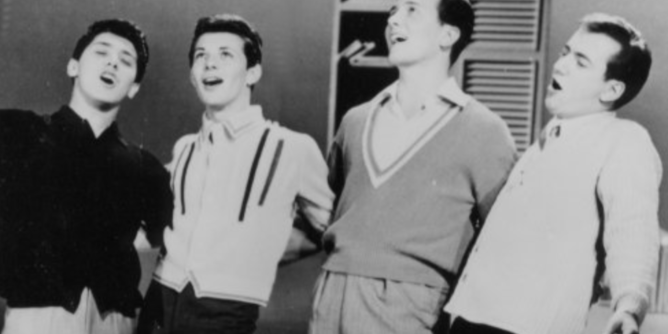
One thing hasn’t changed in broadcasting over the years: The sponsors drive the bus. Back in radio’s golden age, it was pretty overt. The A&P Gypsies, Champion Spark Plug Hour, The Clicquot Club Eskimos, King Biscuit Time, (yup, just like the more recent King Biscuit Flower Hour), The Voice of Firestone and The Bell Telephone Hour, are all examples. As long form radio made the transition to television, some of the sponsor named programs came along.
On June 27, 1960, hoping to maintain its dominance in the soft drink marketplace, Coca Cola presented “The Coke Hour”, featuring a cast that the ABC network hoped would appeal to a teenage audience. Paul Anka, Frankie Avalon, Bobby Darin, Annette Funicello, Anita Bryant, Edd “Kookie” Byrnes and Bob “Maynard G. Krebs” Denver were the guests. The reliable Pat Boone was the host.
Charlie Wadsworth, writing in the Orlando Sentinel, was skeptical. He wrote with the point of view that those of us who grew up in the 60s associate with “The Generation Gap”.
“What will make this show controversial,” he said, “is the fact that these youngsters showed up for a TV program without their lip synchronized recording tricks and, more important, their guitars. Other than for a six minute segment of reviews of some of their big song hits, the tricky-and, we must admit, deplorable recording devices which monopolize the Dick Clark Show and other of their TV appearances, were missing. These youngsters just stood up and sang… Knowing that there has been and would be more talk about their ability, we think these youngsters deserve considerable credit for agreeing to appear on the show. It is to be regretted that such other luminaries of the young record entertainment world as Elvis Presley and Fabian, to mention just two, were not present to· complete this side of the picture.”
The line-up and repertoire were carefully selected to connect with teens while not alienating adults. Bob Denver was in his second year of stardom as the breakout comedy foil for Dwayne Hickman in “The Many Loves of Dobie Gillis” on CBS. Annette, of course, was already a household word, making a smooth transition from Mouseketeer to girl-next-door teen idol. The rest had enjoyed hit records, with Byrnes headed for TV stardom on 77 Sunset Strip and later on film in Grease as Dick Clark doppelganger Vince Fontaine.
The musical playlist naturally included the hits. Maynard and Kookie had a segment where they played 45s, that included, Paul Anka: “Diana,” “Put Your Head on My Shoulder,” “My Home Town.” Frankie Avalon: “Venus,” “Swinging on a Rainbow,” “Why,” “De De Dinah.” Bobby Darin: “Mack the Knife,” “Splish Splash,” “Clementine.” Annette: “Tall Paul,” “O Dio Mio.” Anita Bryant: “Till There Was You,” “Paper Roses.” Pat Boone: “Love Letters in the Sand,” “Tutti Fruitti,” “April Love,” “Why Baby, Why,” and others.
Just when the adults might be reaching for earplugs, Anka, Avalon, Boone and Darin swung into a medley of “Songs Their Mother’s Sang To Them” featuring “Little Girl,” “Chattanooga Choo Choo” and “Goody Goody For You,” all popularized in 1942.
Wadsworth concluded that, “They did all right. Boone, as all of us know, is possessed with a fine voice. The others are even more pleasant to take, without their recording devices. And who are we to argue with a 19-year-old boy (Paul Anka) whose voice, either with or without recording devices, has made it possible for both himself and his parents to retire tomorrow, if they choose?”
Both the cynical columnist and the soft drink company had their eyes squarely focused on the bottom line. Coke’s arch rival, Pepsi, had just come out with “For Those Who Think Young” as a slogan and was gaining in market share. Coke, meanwhile, had just acquired the Minute Maid company and it’s popular orange juice products. Anita Bryant would go on to become pitch-person for the Florida Orange Juice growers, until her political views became to controversial, proving then, as now, that it’s best to keep your persona views to yourself if you’re trying to appeal to the widest possible audience.
Hickman would later say that the Dobie Gillis show represented, “the end of innocence of the 1950s before the oncoming 1960s revolution”.
From the reactions both by the studio audience and the “folks at home”, Coke Time fell into that same category, a categorical success in the process.
And TV Columnist Charlie Wadsworth? He continued writing for Orlando Sentinel until his retirement in 1983. He died in 1999 at the age of 81.
For those interested in a deeper dive, the show is available on DVD.
Here’s rare video of the 45 medley. (Video)

